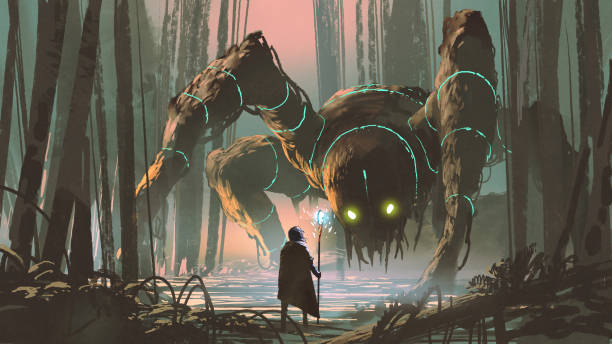Koniguló
Large arachnid like species native to the cold forests and mountains of Iola
Basic Information
Anatomy
Known for their size, legs and penetrating eyes, the Koniguló are adept at hiding in groves and forests as their bodies resemble that of tree trunks and mossy boulders.
Genetics and Reproduction
Koniguló reproduce and lay a small number of rock like eggs in hidden locations like small caves or high in trees. These eggs number around 4-5 and hatch quite quickly.
Growth Rate & Stages
Koniguló have their young quite early and as such tend to stick around and raise their young for some time before the young are ready to be on their own. Koniguló carry their young on their backs as they walk through a forest and protect them by laying on top of them when hiding among the groves.
Ecology and Habitats
Found only in deep forests, caves or places with little human activity
Dietary Needs and Habits
Koniguló feed on large prey from elk, moose and other large animals. Koniguló can even be found sometimes battling bears for scraps of meat and are known to sometimes prefer them over their normally more antlered prey.
Additional Information
Facial characteristics
A Koniguló face is an unforgettable sight, thought to have bioluminescent eyes which when opened give off a greenish glow which they use as a measure to scare off predators. The mouth is a sprawling tangle of tentacle like appendages used to push food into the mouth which typically remains hidden but appears to be lower on the body.
Geographic Origin and Distribution
Inhabit mainly the cold north in deep forests and mountains
Average Intelligence
Shown to be quite intelligent in contrast to their prey, leave traps behind using strands of their hair combined with their weak webbing. Generally Koniguló tend to want to avoid humans as their skin is quite valuable as an ingredient in aloes and other healing mixtures.
Perception and Sensory Capabilities
The Koniguló have hairs on their legs and body that give them a great sense of their surroundings and how they fit into the space they are in. This adaptation allows them to hide much better in the forests and also gives them a vision of what is nearby and if they want to attack or hide from it.
Genetic Ancestor(s)
Lifespan
50-100 years
Average Height
20-30 ft
Average Weight
15-25 tons
Average Length
30-40 ft
Average Physique
Most Koniguló can appear quite bulky as their legs resemble tree trunks which they use as camouflage and their bodies resemble brown mossy boulders again which they use as a way to camouflage themselves from potential predators.
Body Tint, Colouring and Marking
Koniguló have interesting coloring and markings on them. Like their eyes, a Koniguló has bioluminescent bands on its body and legs which can be flashed to scare away predators and may be a method to attract mates as well. Some have been seen to have markings on them which resemble runic inscriptions suggesting run ins with humans who have marked the beasts with protection charms.



Comments